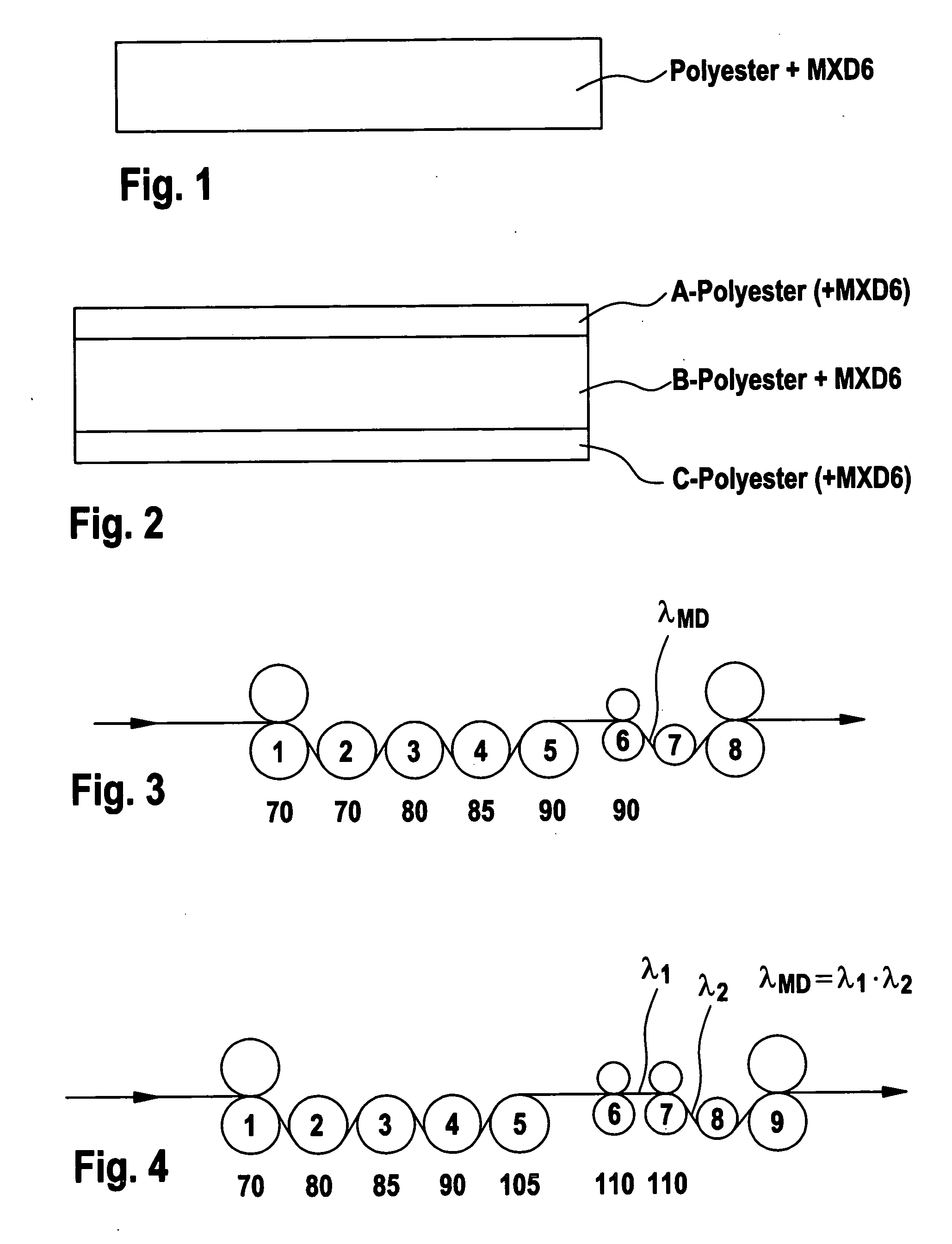Adhesion-promoting polyester film comprising poly(m-xyleneadipamide)
a polyester film and polyvinyl alcohol technology, applied in the direction of packaging foodstuffs, synthetic resin layered products, packaged goods types, etc., can solve the problems of loss of barrier coating comprised of polyvinyl alcohol to the polyester film, low resistance, and the inability to reintroduce the regrind produced during the production process into the production process, etc., to achieve excellent metallizing or vacuum coating suitability and excellent barrier properties
- Summary
- Abstract
- Description
- Claims
- Application Information
AI Technical Summary
Benefits of technology
Problems solved by technology
Method used
Image
Examples
example 1
[0097] Chips comprised of polyethylene terephthalate (prepared by way of the transesterification process using Mn as transesterification catalyst, Mn concentration in polymer: 100 ppm; dried at a temperature of 150° C. to a residual moisture level below 100 ppm) and poly(m-xyleneadipamide) (MXD6), likewise dried at a temperature of 150° C., were introduced in a mixing ratio of 90:10 into the extruder (twin-screw extruder with two vents), and a single-layer film was extruded.
[0098] The film was oriented longitudinally (in two stages) and transversely, the product being a transparent film with total thickness 12 μm. Prior to wind-up, one side of the film was corona-treated, the intensity of treatment being 2 kW / m2.
Film structure10% by weightpoly(m-xyleneadipamide) (MXD6) from Mitsubishi GasChemical Co., product name NYLON ® MXD6 6007,with melt viscosity of 5000 poise80% by weightpolyethylene terephthalate 4023 from KoSa, Germany,with SV 80010% by weightpolyester from KoSa with SV 8...
example 2
[0101] Chips comprised of a copolyester comprised of terephthalate units and of isophthalate units, and of ethylene glycol units (the proportion of ethylene terephthalate being 90 mol % and the proportion of ethylene isophthalate being 10 mol %, prepared by way of the transesterification process using Mn as transesterification catalyst, Mn concentration in polymer: 100 ppm; dried at a temperature of 100° C. to a residual moisture level below 100 ppm) and poly(m-xyleneadipamide) MXD6, likewise dried at a temperature of 100° C., were introduced in a mixing ratio of 90:10 into the extruder (twin-screw extruder), and a single-layer film was extruded. The film was oriented longitudinally (in two stages) and transversely, the product being a transparent film with total thickness 12 μm.
[0102] The film was produced by a method similar to that of Example 1, but without corona treatment downstream of the biaxial stretching process. A latex with 4.5% by weight solids content, comprised of a c...
example 3
[0106] The mixing ratio of MXD6 and polyethylene terephthalate was changed from that of Example 1. In this example, chips comprised of polyethylene terephthalate and poly(m-xyleneadipamide) (MXD6, dried) were introduced in a mixing ratio of 85:15 into the extruder (twin-screw extruder), and a single-layer film was extruded. The film was oriented longitudinally (in two stages) and transversely, the product being a transparent film with total thickness 12 μm.
[0107] The method for production of the film was similar to that in Example 2. An aqueous dispersion with 6% by weight of copolyester, comprised of 95 mol % of isophthalate, 5 mol % of Na 5-sulfoisophthalate, and 100 mol % of ethylene glycol, and 0.56% by weight of colloidal SiO2 was applied as coating to the polyester film by the following process:
[0108] One side of the longitudinally stretched film was coated with the copolyester dispersion described above via reverse-gravure coating.
[0109] The biaxially stretched film was he...
PUM
| Property | Measurement | Unit |
|---|---|---|
| melt viscosity | aaaaa | aaaaa |
| contact angle | aaaaa | aaaaa |
| thickness | aaaaa | aaaaa |
Abstract
Description
Claims
Application Information
 Login to View More
Login to View More - R&D
- Intellectual Property
- Life Sciences
- Materials
- Tech Scout
- Unparalleled Data Quality
- Higher Quality Content
- 60% Fewer Hallucinations
Browse by: Latest US Patents, China's latest patents, Technical Efficacy Thesaurus, Application Domain, Technology Topic, Popular Technical Reports.
© 2025 PatSnap. All rights reserved.Legal|Privacy policy|Modern Slavery Act Transparency Statement|Sitemap|About US| Contact US: help@patsnap.com


